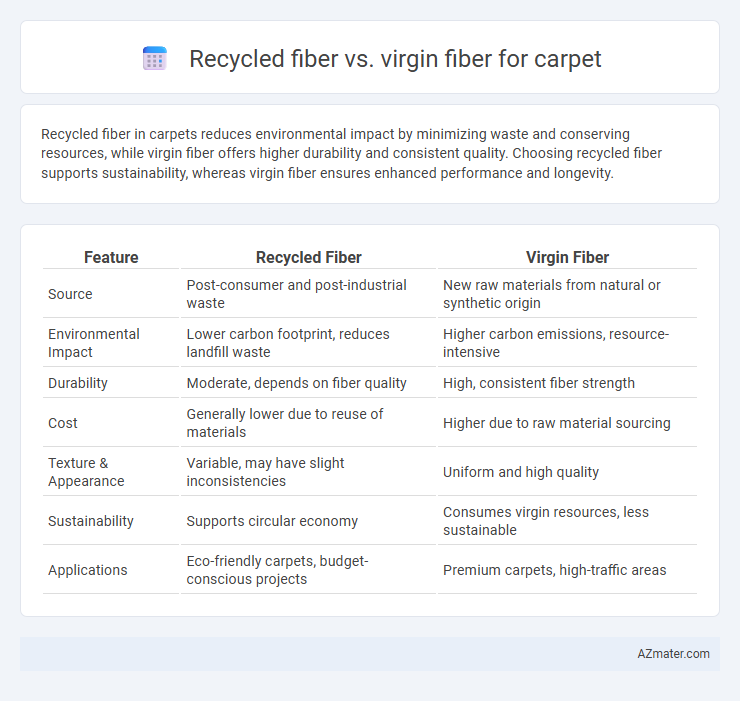Recycled fiber in carpets reduces environmental impact by minimizing waste and conserving resources, while virgin fiber offers higher durability and consistent quality. Choosing recycled fiber supports sustainability, whereas virgin fiber ensures enhanced performance and longevity.
Table of Comparison
| Feature | Recycled Fiber | Virgin Fiber |
|---|---|---|
| Source | Post-consumer and post-industrial waste | New raw materials from natural or synthetic origin |
| Environmental Impact | Lower carbon footprint, reduces landfill waste | Higher carbon emissions, resource-intensive |
| Durability | Moderate, depends on fiber quality | High, consistent fiber strength |
| Cost | Generally lower due to reuse of materials | Higher due to raw material sourcing |
| Texture & Appearance | Variable, may have slight inconsistencies | Uniform and high quality |
| Sustainability | Supports circular economy | Consumes virgin resources, less sustainable |
| Applications | Eco-friendly carpets, budget-conscious projects | Premium carpets, high-traffic areas |
Introduction to Carpet Fibers: Recycled vs Virgin
Carpet fibers can be sourced from recycled materials or virgin fibers, each offering distinct environmental and performance characteristics. Recycled fibers, often made from post-consumer plastics, reduce landfill waste and lower carbon footprints while providing durability suitable for various carpet types. Virgin fibers, derived directly from natural or synthetic raw materials, typically offer superior strength and uniformity, making them ideal for high-traffic areas and premium carpet products.
What are Recycled Fibers?
Recycled fibers in carpet manufacturing are made from post-consumer or post-industrial waste materials such as PET plastic bottles or reclaimed textile scraps, reducing environmental impact by diverting waste from landfills. These fibers often undergo processes like cleaning, shredding, and re-spinning into yarn suitable for tufting and weaving carpets. Compared to virgin fibers, recycled fibers offer a sustainable alternative without significantly compromising durability or aesthetic quality in carpet products.
Understanding Virgin Fibers in Carpets
Virgin fibers in carpets are derived directly from natural or synthetic sources without being processed from reclaimed materials, ensuring superior strength, durability, and consistent quality. These fibers provide enhanced stain resistance and vibrant color retention, making them ideal for high-traffic areas where longevity is essential. Understanding the intrinsic properties of virgin fibers helps manufacturers design carpets with optimized performance, ensuring a longer lifespan compared to recycled fiber alternatives.
Environmental Impact: Recycled vs Virgin Fiber
Recycled fiber in carpets significantly reduces landfill waste and lowers carbon emissions compared to virgin fiber production, which relies heavily on extracting raw materials and consuming more energy. Virgin fiber carpets contribute to deforestation and higher water usage, amplifying their environmental footprint. Choosing recycled fiber supports resource conservation and promotes a circular economy in the flooring industry.
Durability and Performance Comparison
Recycled fiber in carpets offers increased sustainability but generally exhibits lower durability compared to virgin fiber, which maintains higher resistance to wear, crushing, and matting over time. Virgin fibers, often made from nylon or wool, deliver superior resilience and longer lifespan under heavy foot traffic, ensuring consistent performance in commercial and residential settings. Performance tests show virgin fiber carpets retain color and texture better, while recycled fibers may suffer faster degradation, impacting overall carpet longevity and appearance retention.
Cost Analysis: Recycled Fiber Carpets vs Virgin Fiber Carpets
Recycled fiber carpets generally offer a cost advantage over virgin fiber carpets due to lower raw material expenses and reduced energy consumption during production. Virgin fiber carpets, derived from new petroleum-based or natural fibers, typically incur higher manufacturing costs and environmental impact fees, increasing their overall price. Choosing recycled fiber not only reduces upfront costs but also aligns with sustainable purchasing practices, making it a financially and ecologically favorable option for carpet installations.
Installation and Maintenance Factors
Recycled fiber carpets often weigh less, making installation faster and easier compared to heavier virgin fiber options which may require reinforced padding. Maintenance of recycled fiber carpets can demand more frequent cleaning as the fibers might be less resilient to wear, whereas virgin fiber carpets tend to resist stains and retain appearance longer. Choosing recycled fiber supports sustainability but may increase upkeep efforts, while virgin fiber offers durability and lower long-term maintenance costs.
Aesthetic Differences and Design Versatility
Recycled fiber in carpets offers a unique texture and subtle color variations that enhance aesthetic appeal while promoting sustainability. Virgin fiber provides consistent uniformity and a luxurious finish, supporting more vivid dyeing and intricate patterns for high-end design projects. The design versatility of recycled fiber suits eco-conscious spaces with a rustic or contemporary look, whereas virgin fiber caters to elaborate, custom styles requiring precise detail and color intensity.
Health and Indoor Air Quality Considerations
Recycled fiber carpets emit fewer volatile organic compounds (VOCs) compared to virgin fiber carpets, significantly improving indoor air quality and reducing health risks such as asthma and allergies. The manufacturing process of recycled fibers involves less chemical treatment, minimizing exposure to harmful substances like formaldehyde and carcinogenic adhesives. Choosing recycled fiber carpets supports a healthier indoor environment by promoting lower allergen accumulation and enhanced air filtration capabilities.
Choosing the Right Fiber for Sustainable Carpets
Recycled fiber for carpets significantly reduces environmental impact by minimizing waste and lowering energy consumption compared to virgin fiber, which is derived directly from natural resources. Selecting recycled fibers enhances sustainability through decreased carbon emissions and supports circular economy initiatives by repurposing post-consumer materials. Evaluating factors such as durability, texture, and eco-certifications helps ensure the chosen fiber aligns with both performance needs and environmental goals.

Infographic: Recycled fiber vs Virgin fiber for Carpet
 azmater.com
azmater.com